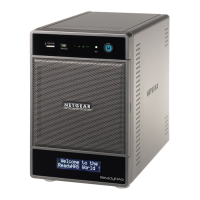System Settings
89
ReadyNAS for Home RAIDiator 4.2
two varieties: static and dynamic. Static IP addresses do not change, but dynamic IP
addresses do change.
Unlike MAC addresses, IP addresses are not assigned by the device’s manufacturer. Static
IP addresses are assigned by your ISP (Internet service provider) or network administrator.
Dynamic IP addresses are assigned by a DHCP (Dynamic Host Control Protocol) server. In
most cases, the DHCP server belongs to an ISP, but a router or other device, like your
ReadyNAS storage system, can also act as a DHCP server.
You can configure how your ReadyNAS storage system negotiates speed and duplex
settings. Speed refers to the rate at which data is transferred across the network. Duplex
mode refers to how communications between two devices on a network are handled.
Full-duplex means that communications from one device to another can happen in both
directions at the same time. Half-duplex mode means that communication can go in only one
direction at a time. For example, in full-duplex mode, Device A can receive information from
Device B at the same time that Device B is receiving information from Device A. In
half-duplex mode, Device B cannot send information to Device A while Device A is sending
information to Device B.
You can also configure the maximum size of packets that are sent across a network. This
setting is called MTU (maximum transmission unit). A large MTU can help speed data
transmission in some circumstances. However, using a large packet size becomes inefficient
if an error occurs during transmission. That is because if any part of a large packet is corrupt,
the entire large packet must be resent. If you use a smaller MTU, smaller packets are resent
if a communication error occurs.
In most environments, your ReadyNAS storage system’s default network settings allow you
to connect and communicate with your ReadyNAS storage system over your local area
network and the Internet. However, you can adjust these settings to accommodate your
needs.
To configure Ethernet settings:
1. Select Network > Interfaces from the FrontView main menu.
The Network Standard Setting screen displays.

